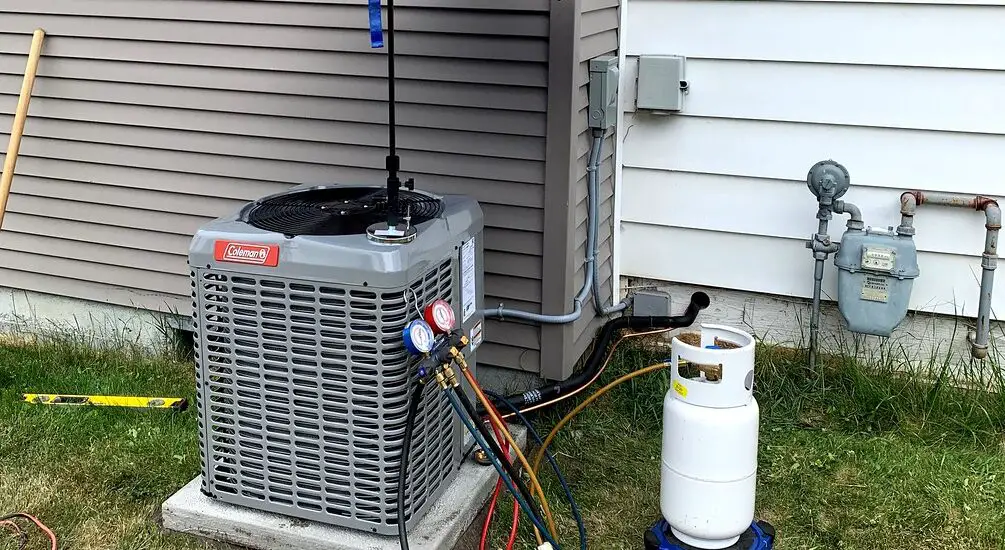R422D refrigerant, isn’t it a mouthful? Well, if you’re into cooling systems, then this is a term you’ll want to cozy up with. Commonly seen as an eco-friendly alternative to the infamous R22 refrigerant, R422D is gaining quite a reputation.

This work is licensed under a Creative Commons Attribution 2.0 Generic License
Table of Contents
What is R422D Refrigerant?
So, what exactly is R422D refrigerant? It’s a blend of hydrofluorocarbons (HFCs), specifically designed to replace R22 in existing air conditioning and refrigeration systems.
The Chemical Composition of R422D
Here’s the science bit – R422D consists of three components: R125, R134a, and R600a. No, they’re not droids from Star Wars. They’re simply types of refrigerants that, when combined, create our eco-friendly R422D.
R422D: The Replacement for R22
R22, the bad boy of refrigerants, has been linked to ozone layer depletion. Can you believe it? The good news is that R422D is seen as a safer substitute, causing less environmental damage. Isn’t that a sigh of relief?
The Use of R422D Refrigerant
Where is R422D Refrigerant Commonly Used?
Wondering where you might encounter R422D? It’s found in a wide range of cooling systems, from your home’s AC to commercial refrigeration units. Let’s break it down.
R422D in Residential Air Conditioning
R422D is a hero in the residential air conditioning scene. It’s a reliable sidekick, helping keep homes cool during those sweltering summer days.
R422D in Commercial Refrigeration
In commercial refrigeration, R422D keeps things chill. Picture a busy supermarket or restaurant – without refrigerants like R422D, things would heat up pretty fast.
R422D Refrigerant: Advantages and Disadvantages
The Advantages of Using R422D Refrigerant
Environmentally Friendly Aspects of R422D
The green credentials of R422D? Spot on. It has zero ozone depletion potential and lower global warming potential compared to R22.
Energy Efficiency of R422D
R422D isn’t just about the environment, it’s about energy efficiency too. It’s been shown to consume less power compared to R22, meaning lower electricity bills. How’s that for a win-win?
The Disadvantages of Using R422D Refrigerant
Cooling Efficiency Compared to R22
It’s not all sunshine and rainbows though. R422D may not cool as efficiently as R22, meaning your AC might need to work a bit harder.
The Cost Factor: Is R422D More Expensive?
And the million-dollar question, is R422D pricier? Yep, it can be. But with its environmental and energy benefits, it might just be worth the extra bucks.
Read more in-depth articles on refrigerants here – Articles on Refrigerants: The Ultimate Guide to Understanding Them
Switching to R422D Refrigerant
Factors to Consider When Switching from R22 to R422D
Compatibility with Existing Equipment
So, you’re thinking of making the switch? You’ll need to ensure your existing equipment is compatible with R422D. You wouldn’t want to invite R422D to the party and have it not mix well with your current system, would you?
The Retrofitting Process: Steps and Considerations
The retrofitting process isn’t a stroll in the park. It involves various steps like removing R22, installing R422D, and possibly making equipment adjustments. So, buckle up for the ride!
Possible Challenges When Switching to R422D
Potential Performance Reduction
Switching to R422D might bring a bit of a challenge. There’s a chance your system’s cooling performance might take a slight hit. But hey, no pain, no gain, right?
The Need for Professional Installation
Here’s a heads up: R422D installation isn’t a DIY job. It needs the touch of a pro. Think of it as calling a doctor for a home visit – you want someone who knows what they’re doing.
R422D Refrigerant Safety and Handling
Safety Precautions When Handling R422D
Equipment Safety
Handling R422D needs some care. Equipment safety is paramount. Make sure to use proper tools and follow manufacturer guidelines. Safety first!
Personal Safety Measures
And let’s not forget personal safety. Handling R422D isn’t like handling a hot potato. You’ll need the right protective gear and knowledge of proper handling techniques.
Disposing of R422D Refrigerant
The Importance of Proper Disposal
Just like its use, disposing of R422D also needs thought. It’s important for the environment, your safety, and legal compliance. Remember, we’re stewards of this Earth, right?
How to Dispose of R422D Safely
Safe disposal of R422D usually means handing it over to licensed waste disposal companies. It’s like passing the baton in a relay – you’ve got to do it right or the whole race could be spoiled.
The Future of R422D Refrigerant
Potential Developments in R422D Usage
Market Trends for R422D
What does the future hold for R422D? Well, with an increasing focus on environmental sustainability, it’s safe to say R422D is on the rise.
Regulatory Impact on R422D Usage
And remember, regulations around refrigerants are always evolving. With R22 being phased out, the stage is set for R422D to shine.
Conclusion
That’s the scoop on R422D refrigerant. It’s an eco-friendly, energy-efficient option that’s increasingly being used in air conditioning and refrigeration. Sure, there are challenges with the switch and some potential downsides. But with a little bit of care and the right help, R422D could be the future of your cooling needs.